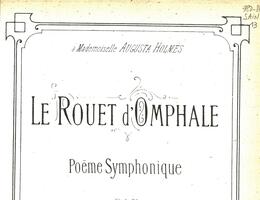Le Rouet d’Omphale op. 31
Poème symphonique créé, dans sa version orchestrale, aux concerts Pasdeloup le 14 avril 1872.
Notice de l’auteur : « Le sujet de ce poème symphonique est la séduction féminine, la lutte triomphante de la faiblesse contre la force. Le Rouet n’est qu’un prétexte, choisi seulement au point de vue du rythme et de l’allure générale du morceau. Les personnes que la recherche des détails pourrait intéresser y verront tour à tour Hercule gémissant dans les liens qu’il ne peut briser, et Omphale raillant les vains efforts du héros. »
“Music exists by itself, outside all emotion […] when one seeks only sensations, art disappears”. Saint-Saëns seemed to be contradicting here, in 1907, what he had said in 1879 in favour of Liszt’s symphonic poems: “For the artist, programme music is simply a pretext to explore new avenues and new effects […]. What art gains by this is not greater beauty, but a wider sphere of influence, a wider variety of forms and greater freedom”. Saint-Saëns appears to have been attempting to justify Le Rouet d’Omphale, Phaéton, La Danse macabre and La Jeunesse d’Hercule. However, his Symphony with organ was to show that he could be just as inventive and innovative without a subject. In fact, the true programme of his symphonic poems was the music itself, and the titles merely tempered the uncompromising nature of his intentions. The composer therefore stated in his note for Le Rouet d’Omphale: “The subject is feminine seduction, the triumph of weakness over strength”. He then declared: “The spinning wheel is merely a pretext, chosen purely for rhythmic purposes and for the general motion of the piece”. The opposite might also prove true when it came to an Invention sur un mouvement perpétuel or an Étude d’orchestration par petites touches. These descriptive episodes, that Saint-Saëns mischievously flagged up to anyone who was interested—“Hercule gémissant dans les liens qu’il ne peut briser” (Hercules groaning in bonds he cannot break; trombones and cymbal roll) and “Omphale raillant les vains efforts du héros” (Omphale mocking the hero’s futile efforts; oboe)—play a formal role at the centre of an ABA’ structure, providing a climax and a new start. The work was first performed in the version for two pianos, then orchestrated and transcribed for 4 hands.

